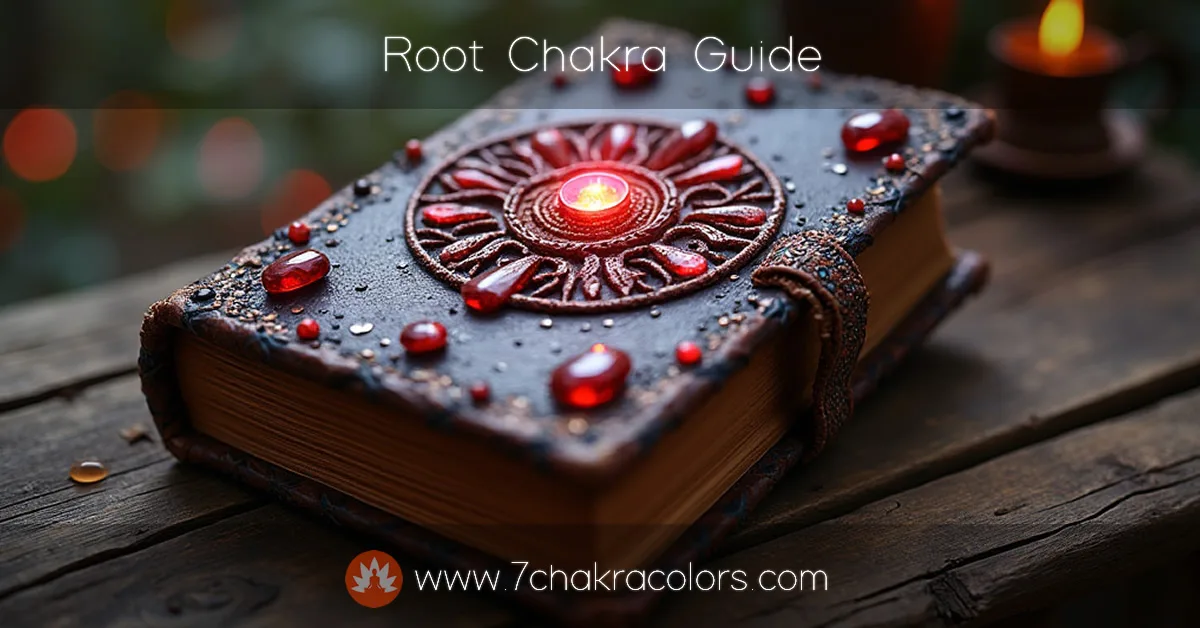
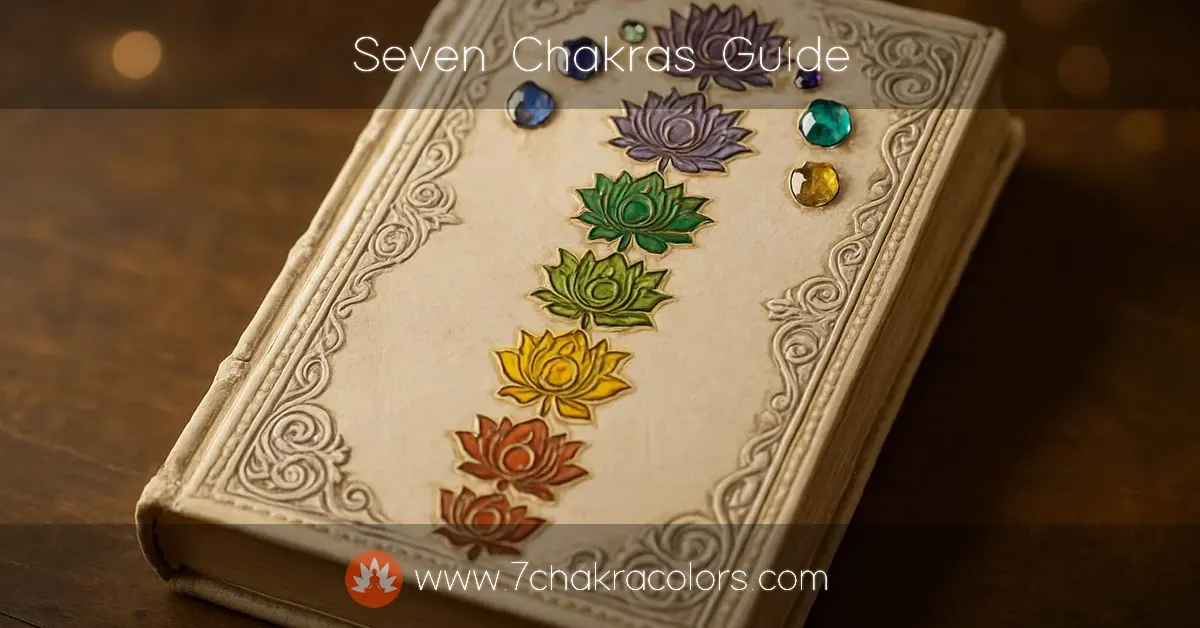
Discover the seven chakras and their exact points on your body. Learn how to open your chakra points for better health and energy flow.
Chakras are energy centers in your body. Vibrational vortexes that pull in energy from around you and push your energy outward. They're the bridge between your physical body and everything else - emotions, thoughts, spirit, all of it.
A balanced chakra processes energy cleanly. No blockages, no interference. It handles the full range of vibrations it's designed for.
When all your chakras are balanced, reality looks different. Your perception clears up because you're reading energy instead of just thinking your way through everything. Life starts flowing. Energy moves through you easily.
That's when you reconnect to nature without trying. You find your path. Work through what you need to work through. Flexibility comes naturally, changes don't throw you off balance. Your intuition sharpens. Walking through life gets easier. You radiate something people notice.
The system comes from ancient Indian spiritual traditions, especially the Vedas - the oldest Hindu scriptures. It maps out how energy moves through your body and how that affects everything about your life.
Started as a spiritual practice, but now it's everywhere. Modern healing, yoga studios, meditation apps. The framework works regardless of whether you approach it spiritually or practically.
Chakra points refer to the specific anatomical locations where these energy centers are positioned along the central axis of your body.
These points line up with your spine, from the tailbone all the way up to the crown of your head.
Each one corresponds to specific vertebrae or areas - you can see exactly where they sit in the diagram below, marked as dots 1 through 7. The transparent colored circles represent where each chakra is felt on your body.
These locations aren't just made up. They sit right where you've got major nerve clusters and glands.
Put your hand on one of these points, breathe into it, whatever - you're hitting both the energy center and the actual physical structures there. One changes the other.
Knowing the exact locations makes the work easier.
You can put your hand on the right spot during meditation. Direct your breath there specifically.
The diagram shows this - colored dots mark where each chakra sits on your spine, and those transparent circles show how far the energy spreads when you're actually tuned into it.
These points work like doorways. You can use them to intentionally shift the energy through your system.
A blocked chakra point doesn't just sit there quietly. You feel it. Tightness in that area. Discomfort. Emotional weight that won't budge.
Working directly with the points - really focusing your attention there - releases what's stuck. Activates what's dormant. Brings things back into balance.
Your body already knows where these points are. That tension at your solar plexus when you're anxious. Your throat closing up when you need to say something but can't. Pressure building between your eyebrows when you're wrestling with a problem.
That's your chakra points trying to get your attention.

The diagram shows the location of the 7 chakra points in the human body.
‘Chakra’ is a word for ‘wheel,’ ‘circle,’ or ‘cycle,’ and is primarily a Hindu concept. However, many other traditions have similar concepts but use different terminology.
Originating from Sanskrit, the word ‘Chakra’ can be translated more directly as ‘a spinning energy wheel’.
That spinning part isn't just a metaphor. The ancient yogis observed energy rotates at specific points in the body - constantly turning, pulling energy in, processing it, sending it back out.

Most people know about seven primary chakras - Root, Sacral, Solar Plexus, Heart, Throat, Third Eye, Crown. These are your main energy centers. The ones you'll work with most.
But that's not the whole picture.
There are actually 114 chakras in your body. They're all connected through something called 'Nadis' - an energy network with 72,000 channels linking every major and minor chakra into one complete energy system.
The seven major ones get all the attention because they're accessible. You can feel them. Work with them directly. They have the biggest impact on your day-to-day experience.
Some spiritual systems go even bigger. Twelve primary chakras in certain traditions, including ones above your head (Soul Star Chakra) and below your feet (Earth Star Chakra). These extended systems deal with cosmic energy and higher consciousness levels.
For practical work though? Start with the seven. Get those balanced and understood. Everything else opens up from there.
Understanding the location of each chakra point is essential for those on a journey of self-discovery and holistic well-being.
The precise locations of the seven chakras are the following:
Chakras reside within the aura, where different human energy bodies (physical, spiritual, etheric, mental) are brought together and form these cone-shaped energy wheels or vortexes.
Each vortex is intimately linked with the other via the nervous system called Nadis. The main Nadi is called the Sushumna and goes straight up the spine from the base to top of the head.
Around the Sushumna, there are two intertwining Nadi channels, called the Ida and Pingala. These flow through each chakra and bring energy to these centers.
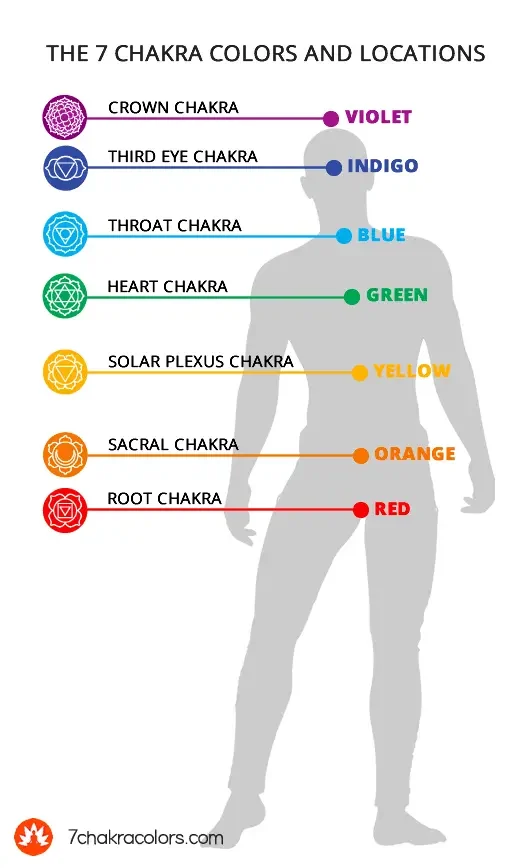
A highly skilled person who can see auras can perceive chakras as pulsating vortexes of spinning energy. There are also different colors attributed to seven chakras.
During chakra meditation, we can often feel chakras spinning as vortexes, or visualize them as such with our inner vision.
These centers which exist in the energetic dimension have a conical shape that extends and opens up to our front and back.
The main seven chakras, as is adopted from Hinduist belief, are aligned along the vertical axis from the base of the spine to the top of the head. Chakras are linked to each other through energy channels called Ida, Pingala, and Sushumna. These are the main lines in a complex system of energy lines and smaller vortexes or knots, called the Nadis.
Charles Webster Leadbeater illustrates the chakras in his book 'The Chakras' the following way:
At its core, the chakra system revolves around the concept of prana or chi, the vital life force that flows through all living things.
Prana moves through energy channels known as nadis and converges at seven primary points in the body, known as chakras, or “wheels” in Sanskrit. Each chakra functions as a center that governs specific physical, emotional, and spiritual qualities.
Chakras are often visualized as spinning wheels of energy that interact with both the internal and external environment. When energy flows smoothly through these centers, we experience balance, well-being, and personal growth. Conversely, blockages or imbalances can manifest as physical ailments, emotional difficulties, or spiritual disconnection.


In the complex system of chakras, the flow of energy is central to maintaining balance and harmony within the body. This energy, often referred to as chi, prana, or life force, travels through three main energy channels: Ida, Pingala, and Shushumna.
These channels are intertwined with the chakras, creating a network that facilitates the flow of energy throughout the body.
Pranayama, the practice of breath control in yoga, plays a crucial role in regulating and directing the flow of energy through these channels. By focusing on specific breathing techniques, practitioners can balance the Ida and Pingala channels, ensuring that the energy flow through the Shushumna is unobstructed.
This balanced flow helps to harmonize the chakras and enhances overall well-being.
Techniques such as alternate nostril breathing (Nadi Shodhana) are particularly effective in stabilizing and purifying the energy channels, allowing for a smoother, more harmonious flow of prana.
The ida and pingala channels, often depicted as intertwining serpent-like energies, represent the subtle currents of lunar and solar energy, respectively. These channels run parallel to the spine and intersect at the chakras, influencing the flow of vital life force. The central channel, known as the shushumna, is considered the primary pathway for spiritual ascent.
Together, these elements form a dynamic network within the human energy body, fostering balance and harmony when in alignment. Practices such as yoga and meditation aim to purify and activate these energy centers, promoting a holistic and integrated approach to health and self-realization.
1. The Muladhara Chakra.
1a. The Mooladhar.
2. The Svadhisthana Chakra.
3. The Manipura Chakra.
3a. The Void.
4. The Anahata Chakra.
5. The Vishuddha Chakra.
6. The Ayna Chakra.
7. The Sahasrara Chakra.
A. Kundalini.
B. Left channel (Ida Nadi).
C. Central channel (Sushumna Nadi).
D. Right channel (Pingala Nadi).
E. Spirit.
F. Ego.
G. Superego.

Your feet hold reflex points for all seven chakras.
Each spot on your sole connects directly to an energy center running up your spine. Press the right point and you're working that chakra - no visualization needed. This comes from reflexology, an ancient practice mapping your entire body onto your feet.
Most people ignore their feet completely. But these pressure points? They're always accessible, always working.
The chakra points follow your body's energy flow from heel to toe:

Physical pressure on these spots stimulates nerve pathways connected to your energy centers. You're not just imagining the chakra opening - you're triggering actual responses in your body.
Your feet stay in constant contact with the earth. That connection matters for energy work, especially grounding through your root chakra point.
The body maps itself in precise ways. Your foot mirrors your spine's energy flow because everything connects through pathways most people never think about.
Basic Technique:
Use real pressure. These points need deep work to release stuck energy. If a spot hurts, that's where energy's blocked - spend extra time there.
That's it. You'll sleep better the first night. After a week, you'll notice your whole energy system feels clearer.
Your palms carry chakra access points most people never use.
Touch the right spot on your hand and you're directly affecting an energy center in your body. No meditation required, no hour-long practice. Just pressure on specific points that connect to your chakras through pathways mapped by reflexology and Reiki traditions.
Your hands move all day - typing, driving, cooking, gesturing. Those seven energy points? They're processing whether you pay attention or not.
The seven chakra points spread across your palm and fingers in a pattern that mirrors your body's energy system:
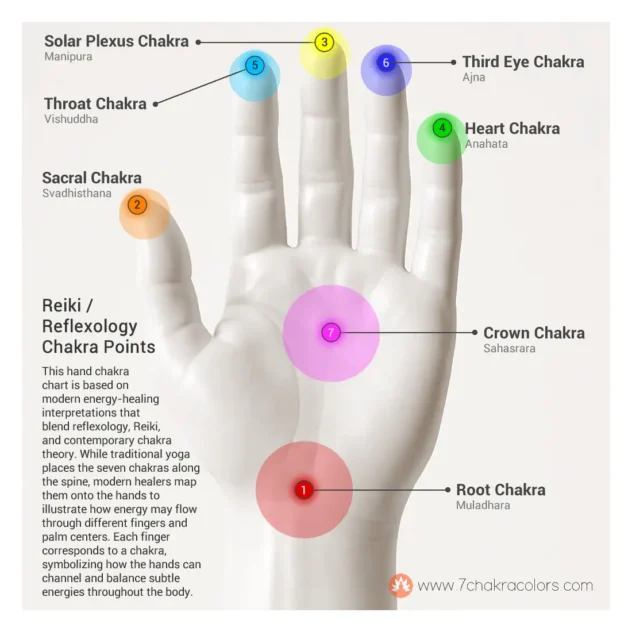
Pressing these points triggers nerve clusters that communicate with your body's energy centers. It's not symbolic - your hands contain concentrated nerve endings that map to your entire system.
Healers have known this forever. Reiki masters channel energy through their palms. Reflexologists work hand points to affect organs and systems throughout the body. The hands aren't just tools - they're energy transmitters.
Working these points consciously lets you reset your energy flow anywhere, anytime. Stuck in traffic? Press your solar plexus point. Anxious before a meeting? Root chakra point in your palm.
The Five-Minute Reset:
Press hard enough to feel it. Gentle touching won't move stuck energy. You want pressure that makes the point respond - not pain, but definite sensation.
Do this every morning, and your baseline stress drops noticeably. Your hands know what to do - you're just giving them permission to work.
Chakras can be understood from several different perspectives, each providing unique insights into their nature and purpose. Below are some key angles from which you can define what a chakra is:
In traditional Indian philosophy, especially in Hinduism and Buddhism, chakras are seen as energy centers in the body through which prana (life force) flows. These energy wheels are situated along the spine and are associated with various physiological and emotional functions. The chakras are believed to control both the physical body and the subtle body, impacting overall well-being.
Chakras can also be understood as vibrational frequencies that resonate with different levels of consciousness. In this perspective, each chakra has its own unique frequency or vibration that corresponds to certain aspects of human experience. This view is common in sound healing and vibrational medicine, where tuning into specific frequencies can help balance or "tune" the chakras.
From a Western psychological perspective, particularly in the work of psychologists like Carl Jung, chakras can be seen as archetypal symbols representing stages of personal development. For example, the root chakra represents basic survival instincts, while the heart chakra represents the capacity for love and connection. This view bridges Eastern mysticism with Western psychological theory, integrating spirituality with personal growth.
Some modern interpretations of chakras attempt to correlate them with the body's endocrine system. In this view, each chakra is associated with a specific gland, like the throat chakra being linked to the thyroid or the solar plexus chakra being linked to the pancreas. This approach takes a more physiological angle, associating the energy centers with physical body functions.
In metaphysical or New Age thought, chakras represent layers of consciousness or dimensions of existence. They are seen as gateways to higher planes of consciousness and deeper spiritual understanding. Each chakra is thought to connect with a different aspect of one's spiritual journey, moving from survival at the root chakra to enlightenment at the crown chakra.
Chakras are often viewed as pathways for healing and transformation in various holistic and alternative medicine practices. This perspective focuses on balancing the chakras to promote physical, emotional, and spiritual well-being. Practices such as Reiki, acupuncture, and crystal healing often target specific chakras to restore energy flow and address health issues.
In the Vedas, chakras are symbolic representations of spiritual and psychic centers that connect the body to cosmic energies. This perspective comes from the deeper esoteric traditions within Hinduism and Tantra, where chakras are seen as divine energy centers, responsible for spiritual awakening and transcendence.
In modern Western yoga and wellness communities, chakras are often taught as part of the body-mind connection. In this view, yoga poses (asanas), meditation, and breathwork (pranayama) are used to stimulate and balance the chakras. This perspective is a blend of traditional spiritual teachings with modern self-care and mindfulness practices.
Esoteric anatomy considers chakras as non-physical energy nodes within the subtle body. They are part of a larger system, including the nadis (energy channels) and auras, and are seen as important for understanding the energetic structure of human beings in occult and mystical traditions.
Some esoteric schools believe that chakras represent evolutionary stages of human consciousness. In this view, as humanity evolves spiritually, the chakras activate progressively, with the crown chakra symbolizing spiritual enlightenment or a higher state of being.
Each of these angles offers a different approach to understanding chakras, whether from the viewpoint of energy, consciousness, psychology, spirituality, or physical health.


Location: Base of the spine
Element: Earth
Color: Red
Associated with: Basic survival instincts, security, and grounding.
The root chakra connects us to the earth and our primal needs. A balanced root chakra leads to feelings of stability and security, whereas an imbalance can lead to issues related to fear, anxiety, or basic survival concerns.

Location: Lower abdomen
Element: Water
Color: Orange
Associated with: Creativity, sexuality, and emotions.
The sacral chakra governs our emotional responses, relationships, and creativity. It is closely linked to the expression of sensuality and pleasure. When blocked, one might experience sexual or emotional difficulties.
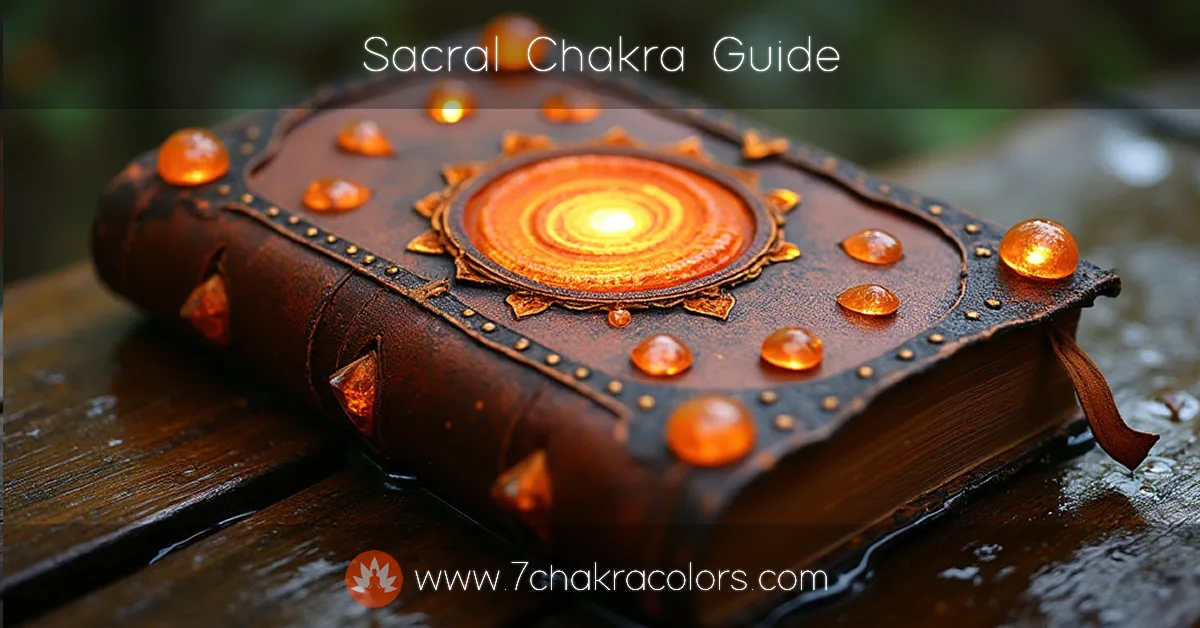
Location: Upper abdomen
Element: Fire
Color: Yellow
Associated with: Self-confidence, power, and identity.
The solar plexus chakra is our personal power center, governing self-esteem, willpower, and autonomy. When balanced, one feels in control and confident. A blocked solar plexus can lead to feelings of powerlessness or digestive issues.
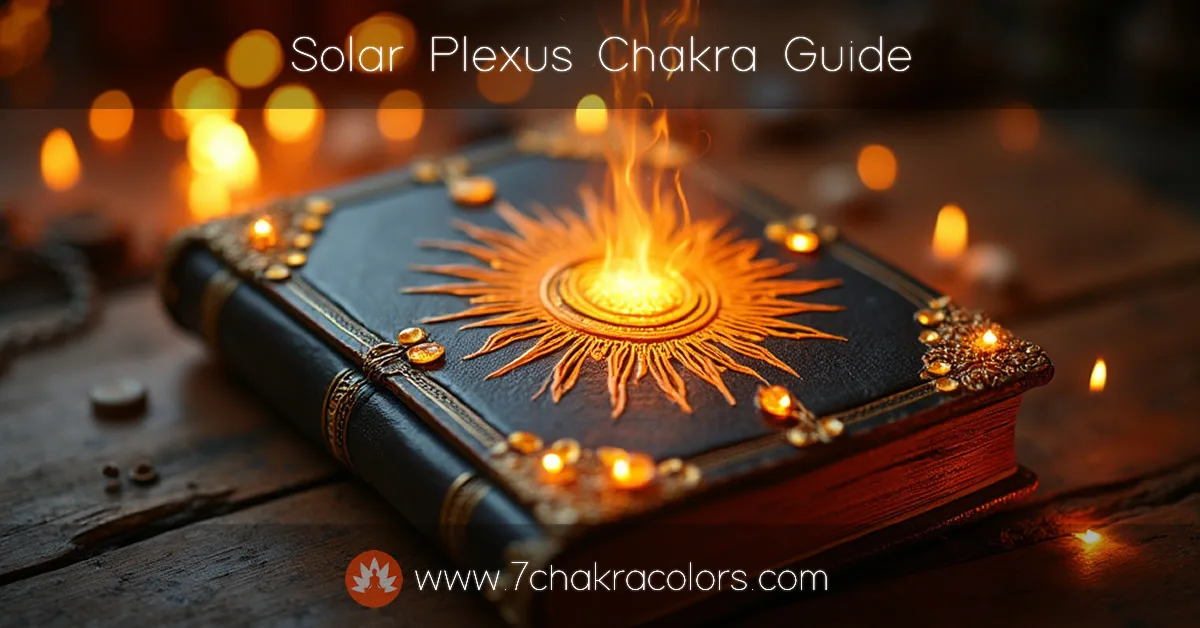
Location: Center of the chest
Element: Air
Color: Green
Associated with: Love, compassion, and emotional balance.
This chakra is the bridge between the physical and spiritual realms, governing love, empathy, and relationships. A balanced heart chakra allows us to give and receive love unconditionally.

Location: Throat
Element: Ether
Color: Blue
Associated with: Communication, self-expression, and truth.
The throat chakra governs how we communicate and express our thoughts and feelings. Imbalances may cause problems with communication or self-expression, while a balanced throat chakra fosters clear, honest expression.

Location: Between the eyebrows
Element: Light
Color: Indigo
Associated with: Intuition, insight, and higher consciousness.
The third eye chakra is the center of intuition and foresight. When balanced, it enhances clarity, wisdom, and spiritual insight; when blocked, it can lead to confusion or a narrow perspective.
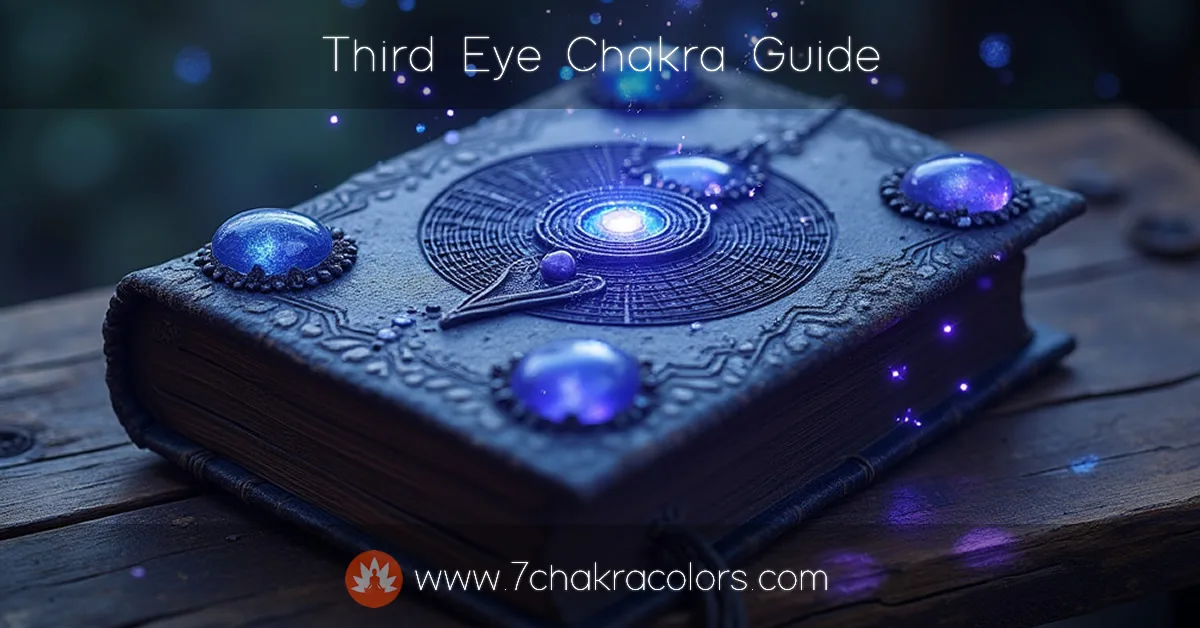
Location: Top of the head
Element: Thought or Universal Energy
Color: Violet or White
Associated with: Spirituality, enlightenment, and connection to the divine.
The crown chakra is the highest energy center, linking us to higher consciousness and universal energy. When blocked, one might feel disconnected from spiritual purpose or meaning.

The easiest practical way for a person to feel their chakras is through meditation and body awareness techniques. Feeling one's chakras requires tuning into the subtle energy within the body, and while this may not happen immediately, with practice, it becomes easier.
By incorporating these practices into daily meditation or self-care routines, people can begin to feel their own chakras and connect to the energy within their bodies. Over time, this helps balance their energy centers and promotes well-being.
Learn everything about chakra stones - from their meanings and properties to practical uses in healing. Discover a comprehensive guide featuring detailed crystal charts, chakra-specific stone recommendations, proper care techniques, and various methods for using these powerful healing crystals in your spiritual practice. Includes a complete table of over 40 chakra stones with their colors, properties, and price ranges.
On this page you'll find:
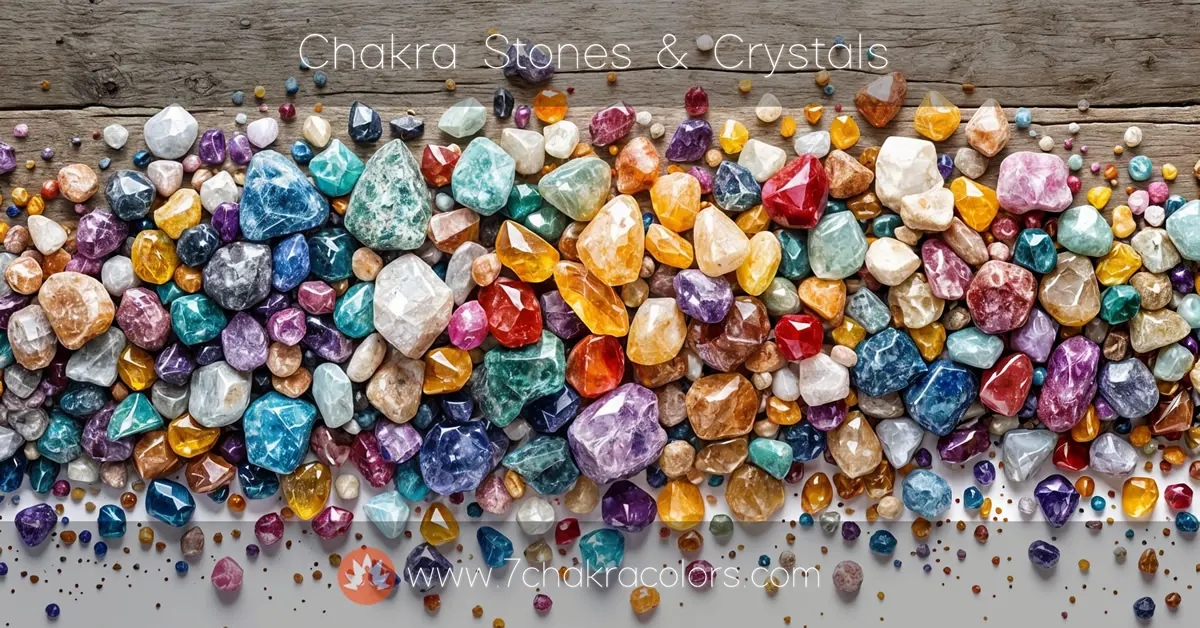
Chakras are more than just spiritual symbols—they represent a powerful model of human development and holistic well-being. By understanding the chakra system, individuals can gain insights into how energy imbalances may affect their physical health, emotional state, and spiritual growth. In modern times, chakras have been embraced as a framework for self-discovery and healing, offering tools for maintaining balance and harmony in life.